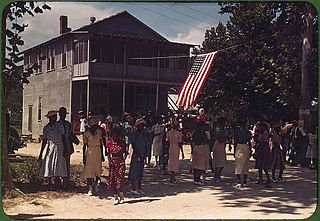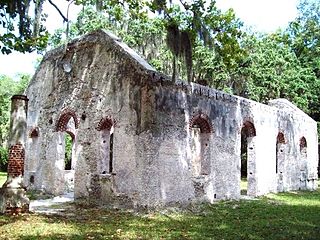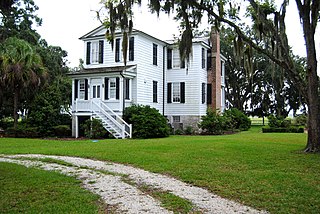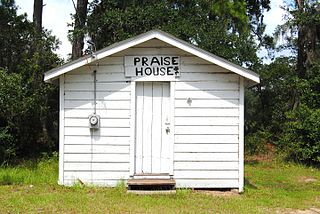
St. Helena Island is a Sea Island in Beaufort County, South Carolina, United States. The island is connected to Beaufort by U.S. Highway 21. The island has a land area of about 64 sq mi (170 km2) and a population of 8,763 as of the 2010 census. It is included as part of the Hilton Head Island-Beaufort Micropolitan Area. The island is renowned for its rural Lowcountry character and being a major center of African-American Gullah culture and language. It is considered to be the geographic influence behind the children's television program Gullah Gullah Island.

Henry Leland Bowles was an American politician who served as a United States representative from Massachusetts.
Frogmore is an unincorporated community on St. Helena Island in Beaufort County, South Carolina, United States, along U.S. Route 21.

St. Helena Parish Chapel of Ease Ruins is a historic site in Frogmore, South Carolina on Saint Helena Island.

The Corner Packing Shed, in Frogmore, South Carolina, is a historic packing house on St. Helena Island that was built in 1930. It was listed on the National Register of Historic Places in 1988.

Coffin Point Plantation, is a historic plantation house located in the Frogmore area of Beaufort County, South Carolina, USA. A Sea Island plantation.

The Coffin Point Plantation Caretaker's House, located in the Frogmore area of Beaufort County, South Carolina and in the shadows of the nearby Coffin Point Plantation, was built in 1892 as a residence for the plantation's caretaker. The Queen Anne style of architecture is considered marginally interesting, but it is noteworthy in that it is the only home known at this time that employed this style. During this era in the plantation's history, the site primary dwelling was owned by James Donald Cameron, who was the Secretary of War under Ulysses S. Grant, and later, United States Senator from 1877 to 1897. The Coffin Point Plantation Caretaker's House was listed in the National Register of Historic Places on May 26, 1989.

The Frogmore Plantation Complex, located on Saint Helena Island, in Beaufort County, South Carolina, is significant for several reasons. First, the plantation home, along with its contributing properties, offers an excellent example of the area's architectural development from 1790 to 1920. Second, the plantation's long association with prominent families contributes to its significance. The plantation was first owned by Lieutenant Governor William Bull, who then willed it to his son in 1750.

Emanuel Alston House is a historic home located on Saint Helena Island near Frogmore, Beaufort County, South Carolina. It was built about 1915, and is a rectangular one-story, vernacular frame dwelling on a brick foundation, with a metal hipped roof. The front façade features a full-width porch, with a low hipped roof. A shed or hipped roof dormer located on the front roof slope provides light and ventilation to the attic space.
Isaac Fripp House Ruins is a historic house ruin and archaeological site located on Saint Helena Island near Frogmore, Beaufort County, South Carolina. The ruins are located at Bay View overlooking the junction of Chowan Creek and the Beaufort River. The two-story, tabby house dates to the early- to mid-19th century. It is associated with Isaac Fripp, a planter of sea island cotton and other staples on St. Helena Island.
Riverside Plantation Tabby Ruins is a historic archeological site located on Saint Helena Island near Frogmore, Beaufort County, South Carolina. The ruins are significant as an example of early- to mid-19th century tabby construction. The ruins are the remains of an outbuilding associated with the Riverside Plantation and have great archaeological potential.
The Oaks, also known as the Cooler House, is a historic plantation house located on Saint Helena Island near Frogmore, Beaufort County, South Carolina. It was built about 1855, and is a two-story, vernacular frame I-House. Edward L. Pierce chose The Oaks as his headquarters during the military occupation of St. Helena during the American Civil War. The Oaks was the center for military and agricultural activities on the island. On June 18, 1862, Ellen Murray, who had ten days earlier arrived from Pennsylvania, opened the Penn School for Freedmen in a back room of the house. The house also served as a hotel for military personnel from Port Royal, superintendents, and teachers.
Lands End Road Tabby Ruins is a historic archeological site located on Saint Helena Island near Frogmore, Beaufort County, South Carolina. The site contains the archaeological remains of a large late-18th to early-19th century house. The site has a tabby foundation pier and the partial outlines of a structure.
St. Helenaville Archaeological Site is a historic archeological site located on Saint Helena Island near Frogmore, Beaufort County, South Carolina. St. Helenaville was a small antebellum village and summer retreat located on the northeastern end of St. Helena Island. St. Helenaville was damaged by several major storms, which ultimately caused part of the village to fall into the sound. There is very little historical documentation of the village. Several remains of tabby and brick are evident.

Tombee Plantation is a historic plantation house located on Saint Helena Island near Frogmore, Beaufort County, South Carolina. It was built about 1790–1800, and is two-story, T-shaped frame dwelling. It is sheathed in clapboard and has a gable roof. It features a single-story front portico with four square columns and a two-story balustraded rear porch with six square columns on each floor. Along with Seaside Plantation, it is one of the few surviving antebellum plantation houses remaining on St. Helena Island. The Tombee Plantation property was divided into tracts during the days of the "Port Royal Experiment" in 1862. It remained in the hands of descendants of freed slaves until 1971.
Seaside Plantation, also known as the Edgar Fripp Plantation, is a historic plantation house located on Saint Helena Island near Beaufort, Beaufort County, South Carolina. It was built about 1795 to 1810, and is a two-story, frame dwelling in a transitional Georgian / Federal style. It features one-story hip roofed portico. Seaside was one of the plantations participating in the Port Royal Experiment and had as its labor superintendent Charles Pickard Ware (1840–1921). Charlotte Forten Grimké (1837-1914) also resided at Seaside Plantation. Along with Tombee Plantation, Seaside is one of only a few remaining antebellum plantation houses on St. Helena. Also on the property are the contributing original, brick-lined well, a clapboard shed, a large barn with clapboard siding and tin roof, and a round concrete and oyster shell silo.

Eddings Point Community Praise House is a historic church located on Saint Helena Island near Frogmore, Beaufort County, South Carolina. It was built about 1900, and is a narrow, one-story gable roofed building of frame construction with the entrance in the gable end. It is significant as one of four known extant African-American praise houses on St. Helena Island, and was a central place in the religious and social life of the black islanders.

Mary Jenkins Community Praise House is a historic church located on Saint Helena Island near Frogmore, Beaufort County, South Carolina. It was built about 1900, and is a narrow, one-story gable roofed building of frame construction with the entrance in the gable end. It is significant as one of four known extant African-American praise houses on St. Helena Island. The building remains in use.
Pine Island Plantation Complex is a historic hunting plantation complex and national historic district located on Pine Island near Frogmore, Beaufort County, South Carolina. The district encompasses six contributing buildings and one contributing sites, and is an early-20th century hunting plantation. The main house at Pine Island was built about 1904, and is a two-story frame structure built on an existing tabby foundation. The front façade features a full-width two-story porch. Also on the property are the contributing cottage, a toolshed/doghouse, a barn, a pumphouse, an automobile garage, and causeway.

Sams Plantation Complex Tabby Ruins is a historic plantation complex and archaeological site located at Frogmore, Beaufort County, South Carolina. The site, possibly built upon and occupied well before 1783. It includes the ruins and/or archaeological remains of at least 12 tabby structures. They include the main plantation house, a rectangular enclosure consisting of tabby walls, a large tabby kitchen, and five tabby slave quarters. Also on the property were a variety of tabby dependencies including a barn/stable, a smoke house or blade house, a well/dairy house, and a well. The property also includes the Sams family cemetery and Episcopal chapel enclosed by high tabby walls. Other structures include possibly an overseer's house, a granary/mill, and a tabby cotton house. During and subsequent to the American Civil War the Sams Tabby Complex was occupied by freedman. Following the Civil War the plantation house was destroyed by hurricanes.















